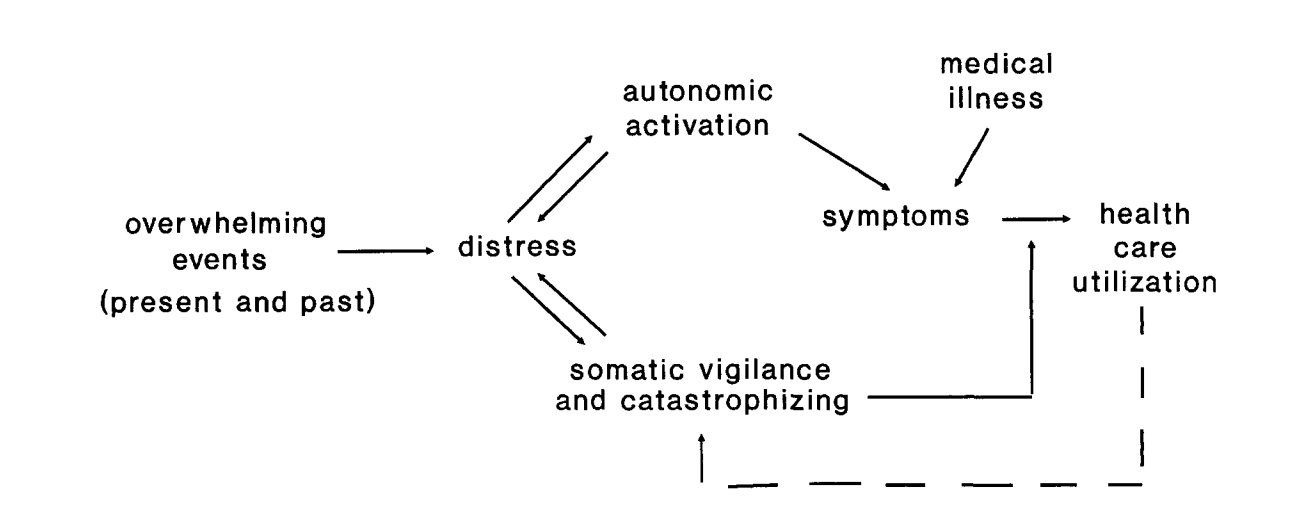Get ready for a little TMI.
TW: I talk about extreme stress in this article, and the bodily functions it impacts.
The cause of your ailment may be stress
According to researchers Mark Sullivan and Wayne Katon’s paper for the Journal of Pain, “Somatization: The Path Between Distress and Somatic Symptoms,” it’s “an extremely common and poorly managed clinical phenomenon.” This paper is from 1993 – so this is something we’ve known about for a while but still, more than 30 years later, don’t have a great set of empirical data for defining it, preventing it, or treating it.
That’s because it affects tons of people (get this – that same report tells us that in the “National Ambulatory Medical Care Survey, 70% of patients with primary or secondary mental disorders presented a somatic chief complaint to their physicians.” That’s still from 1993, and things have only gotten worse), and we don’t yet have a wide consensus on the scientific definition.
We use it in clinical settings but not always in the same context, so there’s a risk of misdiagnosis and also using it as a catchall for functional symptoms for which we can’t pinpoint an acute cause.
The best scientific definition of somatization we’ve found so far:
According to Sullivan and Katon, somatization is “a psychophysiological process wherein cognitive and autonomic factors interact to produce distress that is interpreted as evidence of disease.” Basically, your body feels out of whack in a certain way, and it’s unclear what the physical cause is, because it’s actually a result of how we manage and react to the uncertainties and traumas in our world.
They argue that up until then, somatization was widely recognized as a psychiatric disorder and was referenced in the Diagnostic and Statistical Manual of Mental Disorders, but that it actually could instead be a psychological product that has real affects on our physical body.

Four theories to explain somatization
Researchers claim that the impacts of somatization is much more widespread than we think, it co-occurs with other diseases, and depending on the severity and source, we can treat, manage, and even prevent it.
Sullivan and Katon claim:
- Somatization is among the most common of medical phenomena;
- Somatization frequently coexists with medical illness;
- There is a spectrum of severity of somatization, ranging from acute to chronic; and
- Most somatization is transient and treatable through modification of physician behavior and proper application of psychological and psychiatric therapies
When you don’t know, you know
My sophomore year in college, I was a residential advisor, in charge of making sure 24 freshman students got home safely every night, and (hopefully) to class in the morning. I pretended it was no big deal – I’m the cool RA, I’ll let things slide but won’t tolerate anything sketchy.
Yet, halfway through my chemistry class I found myself running to the bathroom to vomit. As the semester wore on, the classes got harder, and my residents got more bold in exploring their new young adult world. And I got more and more overwhelmed by the pressures on me.
Every morning, I’d head to the bathroom and dry heave for 5-10 minutes before heading to class. Afraid to eat breakfast, it got to a point where my heartburn was so bad I thought maybe I, at the ripe age of 19 years old, had ulcers?!?!
I went to the doctor. I got an endoscopy. They said everything is fine. This symptom can’t be explained.
“It’s probably stress, to be honest,” the doctor said toward the end of the visit. “What are you doing to manage that?”
Physical symptoms of stress
Some of the impacts of stress on a body can range from insomnia to oversleeping, depression, anxiety, headaches, high blood pressure, blurry vision, hair loss, and low energy.
I experienced all of them, over time. Eventually I came to understand which physical response was a response to which type of stress.
- When I had anxiety over a looming situation, I wander around my house at night ruminating and not sleeping.
- When I was feeling overwhelmed by a demand or deadline I felt I just couldn’t hit, I’d get headaches.
- And I knew that the vomiting was the worst end of the spectrum – if I was doing that, I was in an unsustainable, high-stress situation that needed to change.
How did I make permanent shifts?
Well for one thing, I decided to pursue a career outside of traditional 9-5 work, which enabled me to feel much more in control of my business, my income, and my company culture – aka how I treat myself. It required a few other tough decisions – winding down a volunteer position and saying “no” to many new things. And it was so worth it.
To make it stick, I turned these decisions into rubrics so I don’t need to overthink any decision in the future. I always do/never do projects with XYZ criteria, miss important family events for work, even eating – any meeting sent during lunch is declined with a note.
It’s one thing to recognize the alarms your body sounds. It’s another to sense them before they happen and avoid the situations that cause them altogether. I know, that’s a privileged, easier-said-than-done thing to do. But I’ve lost it all before, and there’s nothing worse than the slow decline of holding on for dear life. So I’ll choose the risk of growth, over the risk of staying stuck.
Doing your due diligence
Do not delay in pursuing proper medical evaluation and consultation through your primary care provider. When you get tests results back, they can tell you whether you conclusively have a physical disease that can be treated, or if your ailments may not have a clear physical source. In the case of the latter, you’ll know if you’re like me and under too much stress.
Long term stress management
Managing stress – and I mean really making a lifestyle change to remove the sources of the stress, not just sneaking in some “self-care” every once in a while or buying a health tracker – requires knowing your triggers and patterns.
For example, you might not need to do something drastic like sell your business, but you might need to make a key hire to make it sustainable for you.
As Dr. Huberman says:

Leave a Reply